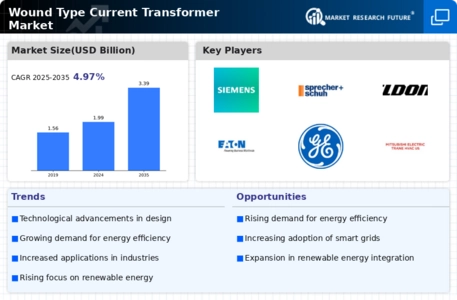Growth in Renewable Energy Sector
The Wound Type Current Transformer Market is poised for growth, particularly due to the expansion of the renewable energy sector. As countries increasingly invest in solar, wind, and other renewable energy sources, the need for precise measurement and monitoring of electrical parameters becomes critical. Wound type current transformers are essential for ensuring the efficiency and reliability of these energy sources. Recent statistics suggest that the renewable energy market is expected to reach a valuation of over 2 trillion USD by 2030. This growth presents a significant opportunity for the Wound Type Current Transformer Market, as these transformers are vital for integrating renewable energy into existing power grids.
Rising Infrastructure Development
The Wound Type Current Transformer Market is likely to benefit from the ongoing infrastructure development initiatives across various regions. Governments and private sectors are investing heavily in upgrading electrical grids and expanding power distribution networks. This investment is crucial for meeting the increasing energy demands of urbanization and industrialization. Recent reports indicate that infrastructure spending is projected to exceed 3 trillion USD by 2027, creating a substantial market for electrical components, including wound type current transformers. As these transformers are essential for ensuring the stability and efficiency of power systems, their demand is expected to rise in tandem with infrastructure projects.
Regulatory Standards and Compliance
The Wound Type Current Transformer Market is influenced by stringent regulatory standards aimed at ensuring safety and efficiency in electrical systems. Governments worldwide are implementing regulations that mandate the use of high-quality measurement devices, including wound type current transformers, to enhance grid reliability and reduce energy losses. Compliance with these regulations is becoming increasingly critical for utility companies and industrial operators. As a result, the demand for reliable and accurate current transformers is expected to grow. Market analysis suggests that adherence to these regulatory frameworks could drive a market expansion of approximately 6% annually, highlighting the importance of compliance in shaping the Wound Type Current Transformer Market.
Increasing Demand for Energy Efficiency
The Wound Type Current Transformer Market is experiencing a surge in demand driven by the global emphasis on energy efficiency. As industries and utilities strive to reduce energy consumption and enhance operational efficiency, the adoption of advanced metering infrastructure becomes paramount. Wound type current transformers, known for their accuracy and reliability, play a crucial role in monitoring energy usage. According to recent data, the market for energy-efficient solutions is projected to grow at a compound annual growth rate of approximately 8% over the next five years. This trend indicates a robust opportunity for the Wound Type Current Transformer Market, as these devices are integral to smart grid technologies and energy management systems.
Technological Innovations in Measurement Solutions
Technological advancements are reshaping the Wound Type Current Transformer Market, with innovations enhancing measurement accuracy and reliability. The introduction of digital and smart current transformers is revolutionizing traditional practices, allowing for real-time data acquisition and improved performance. These innovations are particularly relevant in sectors such as industrial automation and power distribution, where precise measurements are essential. The market for smart measurement solutions is anticipated to grow significantly, with estimates suggesting a potential increase of 10% annually. This trend indicates that the Wound Type Current Transformer Market is likely to benefit from the ongoing technological evolution, positioning itself as a key player in the future of electrical measurement.


















Leave a Comment